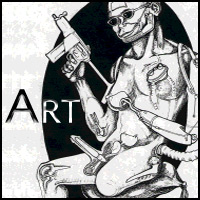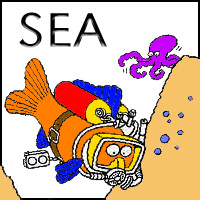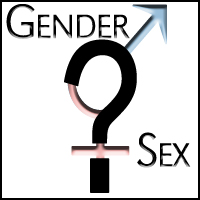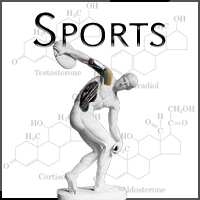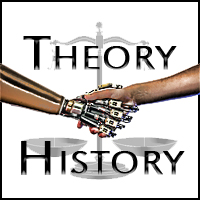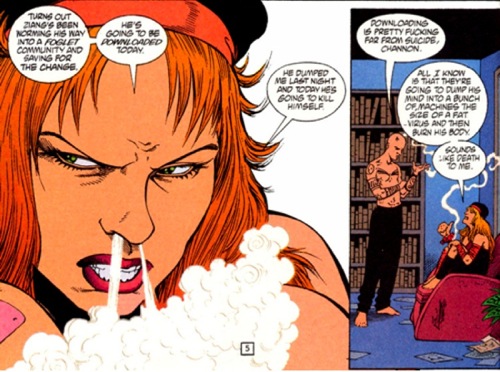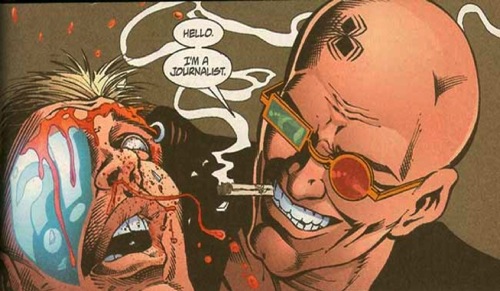
Trust the Fuckhead: A Look at the Cyborgian Aspects of TransmetropolitanKalvin Martinez I first read Transmetropolitan (written by Warren Ellis, penciled by Darick Roberts, and inked by Rodney Ramos), in the spring of 2007. What first struck me about the comic book, (Why not graphic novels?), were the infectious humor, and the brilliant characterization of the main character, Spider Jerusalem. As I dug deeper into the comic, I grew fascinated by Jerusalem's attack on objective and spineless journalism, at the same time; the vivid illustrations of the cyberpunk landscape riveted me. While the technological advances of this supposed future often makes it seem like a bleak and dejected place. A place where people seem to retreat into technology and spurn their humanity, but it is through the focalization of Spider Jerusalem that gives warm and a heart to all of these wonders of the city. Without the eye of Jerusalem, the city in Transmetropolitan would seem dystopian instead of cosmopolitan. Mark Oehlert ‘s article, “From Captain America to Wolverine” detailed the cyborgian superheroes of the 90s and discussed with the implications of people with powers that rival armies and how they might affect future wars. However, Oehlert was writing about comics during the speculation era, (Your term or the one from the lit?), where comics were over sensational and ultra violent. As such, his article focused on the military applications and problems. This article will deal with much more mundane, in the sense that personal use and practical application is mundane, aspects of cyborgian applications as seen in Transmetropolitan. One portion of Oehlert's article that still can be of use is his classifications of cyborgs. The first he details is the controller, which he further divides into three categories, but for simplicity sake, a controller is a cyborg that has detachable tech or prosthesis, which enhance the user (Oehler 222). The next is bio-tech integrator where, “Their systems can not be removed and often they are not fully explained either” (224). A bio-tech integrator is a cyborg where the tech is implanted into the organism and is fully integrated with the user. The third classification is the genetic cyborg, “characters in this class may or may not have artificial implants but their primary power rests in a purposeful alteration of their genetic code” (224). Using these categories is an easy way to focus on the cybrogian technology in Transmetropolitan.
The illustrations by Derrick Roberts in the pages of Transmetropolitan are rife with futuristic cyborg technology, but the workings and details of these devices and technologies are not explained at length in the comic, rather the illustrations are so detailed and vivid that the functioning of said devices are easy to extrapolate upon. However, there are three single issues of the comic that do go into great detail about some of the technologies, those being issue #7, “Boyfriend is a Virus”, issue #8, “another cold morning”, and issue #9, “WILD in the country”. Each issue I will discuss in more detail later, but first it is prudent to look at some of the less enumerated details of Transmetropolitan, in order to show how rich the future landscape is in the comic. In issue #2, “down the dip”, Spider goes into The Angels 8 District to find the leader of the “transient” group, Fred Christ, an old contact he use to know back when he was a sleazy ban manager, for an interview. The Angels 8 District is the slum where the “transient” population of The City lives. Spider starts his interview with Christ by asking Chirst to explain the whole “transient” concept to him since he has been out of The City for a while (this also shows how much technology excels even if a person is out of The City for a few years). Christ tells him that alien cultures do not have much to trade, and that with world culture exhausting the initial alien fashion in two years, they needed something else to trade (Ellis/Roberts “down the dip” 37, 1-2). Christ says the aliens found an outlet when body modification became popular again and the early “temping” technology was available. “Temping” was a small trend that was popular in Brazil for temporary morpho-genetic plug-ins, which allowed people to vacation in reptile skin or spend a month in feathers (37, 3-4). Christ goes on that from “temping” the next obvious step was a permanent change in species, but says that there is not much use in being bonded with animal DNA, as it has no advantages. However, becoming another sentient humanoid has its appeal, and the aliens found a resource in selling their genome to dedicated tempers (37, 4-5). The reason the people are “transients” instead of “tempers” is that “tempers” are visiting a new body, but the “transients”, “are literally BETWEEN BODIES” (37, 6). In Oehlert's classifications, “transients” would be genetic cyborgs. The cyborgian aspect of the “transient” population, it lies in the fact that these people use the technology of genetic manipulation to change species, but more specifically as Fred Christ says, in body modification. The decision to go from a human body to a partial or full alien body (or even any number of animal-human body configurations as is available) is not far-fetched. Instead, it is an evolution of the type of body modifications that people currently undergo, for instance, “Cat Man”, who underwent surgical procedures so he could look more like a cat. However, in Transmetropolitan instead of simply looking like a cat, he would have cat DNA implanted inside him and actually be a cat, or at least a cat-human hybrid. Outside of body modification, the idea of actually becoming something other than human is not new, the concept of metamorphosis from human to something other is an ancient idea with links to Homer's The Odyssey in the form of Circe, and even to the generic tale of the animal bride. This is to suggest that the idea of transience in Transmetropolitan is not an outlandish idea or impossibility, but rather an expression of current and ancient trends/idea that science will eventually find a way to turn masquerade and fiction into a firm reality.
A majority of the technology in Transmetropolitan falls under the category of Oehlert's second classification of bio-tech integrator. In issue #21, “The New Scum 4: New Streets”, there is scene between a woman in a violet-metallic suit with wires protruding and jacks covering her body, and a man in a grayish-blue metallic suit similarly outfitted with wires and jacks all over his body (Ellis/Roberts 9, 1). In the scene, the woman and man are facing the other and looking affectionately at them, as the scene progresses, wires begin to emit from various parts of their bodies and attach to the jacks on the other's body (9, 2-4). As they move to kiss, it shows that their tongues have jacks that act as electrical outlets, which allows them to connect even further (9, 5). The scene ends with more wires intertwining their bodies, them telling each other, “I love you”, and culminates in them having sex (10, 1-3). Obviously, because of their technology they do not have sex as average human beings, but instead experience sexual gratification through linking their systems to each other. Considering the nature of these people's technological integration, it is probable that the pleasure they experience by linking up is far more intense than a normal sexual interaction or orgasm. Alex Rivera uses the concept of integrating the nervous system with technology in his film, Sleep Dealer (2008). However, in the film the jacks are much more organic looking, and not techno-futuristic. The process of interfacing with another person's hook-ups in the film allow the person to access the other's nervous system and become more intimate than normal genital to genital relations. From the illustrations, the sexual process functions similarly to sexual acts in Sleep Dealer. This correlation shows that the concept has appeal and that this integration of organic and machine could be possible because of the ability to interface directly with other machines, but also because of its sexual applications could be appealing to the number of people who want to experience more pleasure during intercourse. Issue #26, “21 Days in the City”, features two cyborgian aspects that fall in line with both bio-tech integration, and sexual gratification. The first deals with a bio-tech integrator in terms of drug use with a what is called “doing mechanics” (Ellis/Roberts 5). “Mechanics” is a new drug that the user does by connecting to a small computer AI computer brain similar to the used in “Makers”, appliances that reorganizes atoms into food, clothing, etc. (5). The user has the AI scan the drug the user wants to do, do the drug themselves, and both the computer and human get “fucked up” (5). The drug creates a connection between the human mind and the AI, during the connection the AI breaks into the mind a rearrange human DNA and forms mineral matter resulting in the growing of machines (5). The aftermath of the high is that the user now has pieces of machine around his body (5). When considering the designer drug explosion in the forms of LSD, ecstasy, PCP, methamphetamine, and the resultant health risks associated (“designer drugs”), the idea of “mechanics” is entirely possible. If anything, the fact that such a drug is not existent yet is only a result of current sciences not being able to integrate biology completely with technology. However, once science advances to that point, a drug similar to “mechanics” is sure to follow because only human desire to find new ways to get off rivals the human desire to find new ways to get high. “21 Days in the City” also features Oehlert's simple controller class, in the form of a current technology, but progressed to the point of practical application. It is the progression of penile implants, rather than the awkward and ineffectual models of today, Matteo's new genitals are similar to his regular ones except that it has a Minidisc player inside it (Ellis/Roberts 6). It is easy to imagine this becoming reality considering crude versions of such technology already exists. What is notable about this prosthetic penis is that it functions similarly to an organic penis, which is something that current penile prosthesis does not do. Even the humorous addition that the penis has a Minidisc player is not bizarre or insane, outside that, no man would get his penis fitted with a dead technology, but the idea of having an iPod or Zune inside a future penile prosthesis is not out of the realm of possibility. In fact, as the prosthetics become more sophisticated it will probably be the basic feature of it similar to how an MP3 CD stereo is in a car. The last series of panels that I will look at is from issue #28, part 1 of “Lonely City”. Before looking at the technology in question, it is prudent to discuss what a “trait” is in Transmetropolitan. When characters in the comic book talk about “traits”, they are talking quite simply about genetically altering or engineering specific physical traits to their liking. “Traits” are a class three, genetic cyborg application. In issue #9, “WILD in the Country”, which will be discussed later, during a bar conversation between two men, one talks about “the Berlin Wall conservation” as “fuck central”, but that neither of them could not get laid there because their sperm is too tampered with and would contaminate the preserved culture (Ellis/Robertson 6, 1-2). The first man uses the example of the other's son, Eichmann who has the “anti-cancer trait” and as the other man pushily points out designer warts, both “traits” that the son inherited from the father's sperm (6, 2-3). Genetic engineering has gotten so advanced in the comic that a cure for cancer is passed down genealogically. In the case of “designer warts” that is a “trait” that makes the person's penis look like a “goddamn sex porcupine”, which makes “girls love him” (7, 2); science once again goes from practical to sexual gratification. There are many different types of “traits” and not all are simply for the betterment of getting off, some have practical applications like the “anti-cancer trait” like in the instance of the “trait” discussed in part 1 of “Lonely City”. In issue #28, Spider asks for a phone, and his assistant, Yelena responds by throwing a pill vial at his head. At the same time she explains it is a “phone trait” that grows an antenna web over the users skeleton and runs off their metabolism (“Lonely City” 19, 1-2). The interface is the “usual biotech consumer goods” one where menu maps over the left eye, with an imaginary key pad controlled by right eye and hand. The “phone trait” is both amazing and seemingly another natural progression. It at once shows how sophisticated genetic engineering is in Transmetropolitan, while at the same time being a mundane technology to the point that such a marvel is throwing at the back of someone's head. Considering the trend for phones to be more intuitive/smart/smaller/easier to use, the idea of a phone that is part of someone is another invention that will be wide-spread once current science becomes sophisticated enough to implement them. This is not simply a matter of genetic engineering, but of ubiquitous computing. Ubiquitous computing as Marcia Riley defines it in her article, “Ubiquitous Computing: An Interesting New Paradigm” is “a paradigm shift where technology becomes virtually invisible in our lives. Instead of having a desk-top or lap-top machine, the technology we use will be embedded in our environment” (Riley). What is more embedded in environment than a phone inside a person? A phone that is a part of a person will become reality once both genetic engineering and ubiquitous computing progress enough that they will be able to create the iPhone for the eyes. With the cyborgian elements of the comic examined, now it is possible to look into the meatier elements in the series of single issues #7-9. Links/Sources
Ellis, Warren (w), Darick Robertson (p), and Rodney Ramos (i). "down the dip." Transmetropolitan #1 (October 1997), DC Comics. 37, (1-6).
Pictures/Illustrations:
Illustration 1: http://billet-deaux.com/ellis/ellis02.html
|




